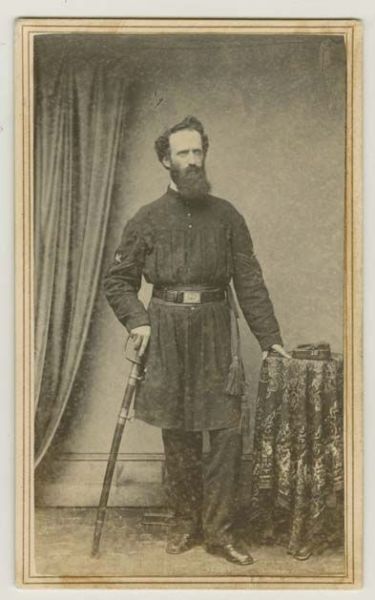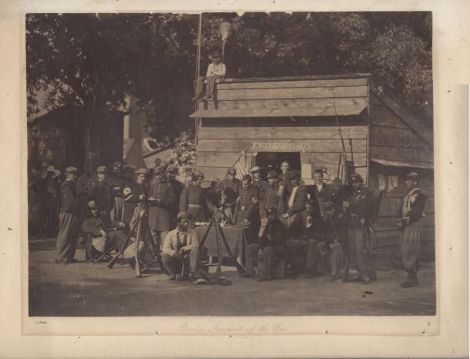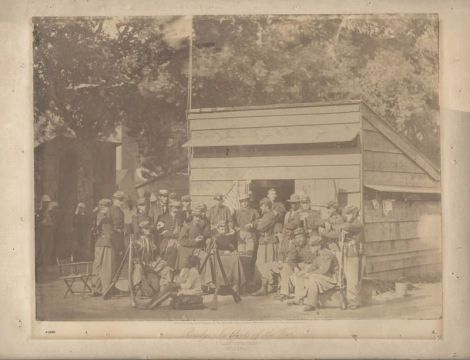12th Regiment, New York National Guard
Nickname: Independence Guard
Left the State: April 21, 1861
Mustered in: May 2, 1861
Mustered out: August 5,1861
Left the State: June 6, 1862
Mustered out: October 8,186
Left the State: June 20, 1863
Mustered out: July 20, 1863.
The following is taken from New York in the War of the Rebellion, 3rd ed. Frederick Phisterer. Albany: J. B. Lyon Company, 1912.
This regiment was organized as the11nth Regiment by a general order dated June 21, 1847, and was of eight companies, viz.: Light Guard of 106th Regiment; Benson Guard, of 125th Regiment; Independence Guard, of 264th Regiment; Italian Guard, of 252d Regiment; Monroe Blues, of 235th Regiment; Tompkins Blues, of 51st Regiment; Independent Tompkins Blues, of 222d Regiment, and Lafayette Federalizes of 85th Regiment. By a general order dated July 27, 1847, the designation of the regiment was changed to the I2th. A new company, under command of Capt. Henry Johnson, was organized and attached to the regiment, April 25, 1849. Company H of the 3d Regiment was transferred to the I2th Regiment, April 25, 1849. Company D was consolidated with Company C, June 5, 1849. A new company, under Capt. Adolphus I. Johnson, was organized April 15, 1850. Company L was transferred to the nth Regiment, May 3, 1858. On March 16, 1859, Companies A and C, B and H, and G and E were consolidated, and the consolidated companies, with Company D, transferred to the l0th Regiment. On June 29, 1859, these transferred companies were disbanded. On November 16, 1859, five companies (A, B, C, D and G) were organized in the 22d Regimental District. On November 22, 1859, Company E was organized and an election ordered for field officers of the 22d Regiment. These companies were composed principally of former members of the old I2th Regiment The designation of the 22d Regiment was changed December 19, 1859, to 12th Regiment. Company H was organized January 28, 1860, and Company F, February 2, 1860. Company C was consolidated with Company E, March 21, 1861, and Company K was organized May 8, 1861. Company I, 23d Regiment, was transferred to I2th Regiment, as Company I, April 2, 1861. New Company C was organized December 31, 1861. Company K was disbanded February 12, 1862, and new Company K organized September 22, 1862. Company C was consolidated with Company H, January 12, 1876. Company I was consolidated with Company G, January 12, 1876. New Company I, organized February 21, 1876. Company D was consolidated with Company E, March 11, 1876. New Company D was organized July 16, 1884, and new Company C was organized June 3, 1885. The regiment performed duty during the Astor Place riots in 1849; it was on duty during the Orange riots in July, 1871; during the Railroad riots in July, 1877; during the Switchmen's strike at Buffalo, in August, 1892, and at Brooklyn during the Motormen's strike in January, 1895. April 28, 1898, the regiment was authorized to be organized as a twelve company regiment to enter the United States service, in which it was mustered in as the 12th Regiment Infantry, N. Y. Volunteers, May 13, 1858, and mustered out April 20, 1899; Companies L and M were disbanded April 24, 1899.
Service in the War of the Rebellion.
April 21, 1861, the regiment, ten companies, commanded by Colonel Butterfield, left the State en route to Washington, D. C., where it was mustered in the United States service, for three months, May 2, 1861. It served at and near Washington from May, 1861, and in the Army, Department of Pennsylvania (General Patterson); and was mustered out at New York city, August 5, 1861.
After the regiment's return from this service a large number of its members entered the volunteer service, for three years, in an organization known as the I2th Militia, which was, in January, 1862, consolidated with the 12th Volunteers.
May 27, 1862, the regiment, nine companies then commanded by Col. William G. Ward, was again ordered to Washington, D. C., and left the State, June 6, 1862; it was mustered in the United States service for three months, served at Harper's Ferry, W. Va., in the 4th Brigade; volunteered to stay over its term of service, and was surrendered with Harper's Ferry; it was mustered out at New York city, October 8, 1862, and declared exchanged January 11, 1863.
June 18, 1863, the regiment, ten companies, was ordered to Harrisburg, Pa., and it left the State, under Colonel Ward on the 20th; it was mustered in the service of the United States, for thirty days, served in General Yates' command at Fenwick, Pa., and in the 1st Brigade, Dana's Division, Department Susquehanna, and July 20, 1863, was mustered out of that service at New York city.
The regiment lost, died of disease, in its service of 1861, two enlisted men,; and it, or portions of it, took part in the following engagements, etc.:
Occupation of Arlington Heights, Va., May 24, 1861; skirmish near Martinsburg, Va., July 12, 1861; skirmish near Bunker Hill, W. Va., July 15, 1861; skirmish on Maryland Heights, Md., September 12-13, 1862; siege and surrender of Harper's Ferry, W. Va., September 12-15, 1862 (30 officers and 530 enlisted men were surrendered).
The following is taken from Third Annual Report of the Bureau of Military Statistics of the State of New York, Albany: [The Bureau], (C. Wendell), 1866.
TWELFTH REGIMENT, N. Y. S. MILITIA.
The Twelfth regiment is in the Second brigade, First division of the State militia organization. It organized in the city of New York, tendered its services through its commanding officer, Colonel Butterfield, immediately on the breaking out of the rebellion, for the defense of the National Capital.
The friends of the regiment in the city, contributed liberally towards its equipment, raising the sum of $10,000. New uniforms were ordered, but without waiting for their completion, the regiment commenced at once recruiting its ranks ; and although at the inspection in the fall of 1860, it showed but 380 men, so great was the enthusiasm of the citizens and the popularity of the Twelfth, that when it left for the seat of war its numbers had been increased to nearly 1,000.
On the 19th of, April, 1861, orders were issued from General Headquarters, directing Major-General Sandford to detail the Twelfth for immediate service at Washington, and on Sunday, the 21st, the regiment took its departure from the State. The regiment assembled in Union Square, the regular members and their substitutes wore their old regimental uniform, but the recruits wore their ordinary clothing with military belts and equipment. A supply of muskets had been obtained, and guerrilla like, as the raw recruits looked, there was hardly ever a finer body of men gathered together, and the spectators by their enthusiasm, showed what they expected of them. Great masses of the population turned out to do honor to the departing Militia. It was with difficulty that the regiment made its way through the crowd to the wharf, and was obliged to leave Broadway and turn down a side street into Mercer street, the throng was so great. The regiment left New York in the steamship Baltic for Fortress Monroe. On the voyage, the recruits were drilled into very serviceable shape. It had been intended that the regiment should go up the Potomac, but orders were received from General Butler, then in command at Annapolis, that the Twelfth should proceed to that point. The Twelfth was transfered from the Baltic to the steamer Goatzacoatcos, and the fleet of vessels (containing the different Mili¬tia regiments), as they steamed up the Chesapeake, presented a grand appearance. On Friday, the 26th, the regiment landed and started on its march to Junction, where it arrived the next day, after a bivouac in the fields over night; continued their march on Saturday, and in the evening bivouacked in the woods. On Sun¬day afternoon, took cars for Washington; were there placed in tem¬porary quarters until the 7th of May, when the regiment moved to Camp Anderson, in Franklin Square. About the same time they received from New York their new Chasseur uniform, which was complete and acceptable. A severe course of drilling was immediately commenced, which soon brought the regiment to remarkable state of perfection. Several officers, who had just graduated at the United States Military Academy, were assign-ed as instructors to the different companies, in consequence of the number of recruits, and also drilled the officers in skirmishing.
Among those who were prominent in performing this duty, worn Lieutenants Upton and Ames, both subsequently promoted to the rank of Brigadier-General, and the latter of whom, (General Ames), was conspicuous for gallantry at Fort Fisher. On the 23d of May, the regiment received marching orders, and on that night crossed the Long Bridge under the direction of General Sandford, and matched into Virginia, being the first regiment to invade the so called "sacred soil" of that State. Established position at Roach's Mills, forming the extreme left of the army. At that period, the regiment mustered present for duty, 829, and on the rolls an aggregate of 981 men, Capt. B. S. Church, of the engi¬neer corps of the regiment, reconnoitered the adjoining country for miles around, on horseback and alone; he was once captured by a party of rebel cavalry, but managed to escape. Subsequently he was detached from the regiment, on special duty, and engaged in company with Lieutenant Snyder, of the U. S. Engineers, in choosing the sites of the extensive fortifications on Arlington Heights, when he as repeatedly fired upon by rebel scouts.
While at Roach's Mills, the regiment was frequently drilled in skirmishing. The citizens of Washington, however, residing in the vicinity of Franklin Square, were desirous that the Twelfth should be recalled to its old quarters, fearing that some less orderly regiment might be stationed among them. The War De¬partment acceded to their request, and accordingly on the 2d of June, the regiment was marched back across, the Long Bridge, and returned to its former camp in the city.
The regiment, remained in Washington until the 7th of July, when, ordered to join the army of the Shenandoah, it proceeded by railroad to Baltimore, and thence to Harrisburg and Hagers¬town, arriving at the latter place on the evening of the 8th. Left Hagerstown on the 9th, marched to Williamsport, forded the Potomac and marched all night; arriving at Martinsburg, Va., early on the morning of the 10th, having accomplished 80 miles without a pause. Colonel Butterfield, there reported to Major-General Patterson, and was immediately appointed an acting Brigadier-General, his brigade consisting of the Fifth and Twelfth N. Y. S. Militia, and the Nineteenth and Twenty-eighth N. Y. S. volunteers. Lieutenant-Colonel Ward then took command of the Twelfth. While at Martinsburg, a foraging expedition was formed, consisting of three companies of the Twelfth, and three of the Twenty-eighth regiment N. Y. S. V., which was quite sucessful, and enlivened by a slight skirmish with the rebels, a detachment of whom endeavored to interfere with the operations, but were dispersed by a volley from company H, commanded by Capt McCormack. This was on Friday the 12th of July. On Monday July 15th, the army advanced to Bunker's Hill; where they were encamped for a day, the Twelfth being stationed near the Sulphur Spring, at a foot known for the time as Camp Patterson.
On reaching Bunker's Hill, found it occupied by the rebel advance, who retreated in great haste after a slight skirmish, in which a Rhode Island battery threw several shells, killing one and wound¬ing two of the rebel cavalry. On Wednesday, July 17th, left Bunker's Hill and marched to Charlestown, where the regiment encamped, and on Sunday, the 21st of July, marched to Harper's Ferry, and occupied a position on Bolivar Heights, close to the spot where the rebel batteries had been planted by Johnston, who had also fortified the place by building block-houses on Loudon Heights across the Shenandoah. Doubleday's battery was sta¬tioned on Bolivar Heights, and took possession of several large guns which had been abandoned by the enemy, when they hastily evacuated Harper's Ferry, as untenable.
Col. Butterfield tendered the services of the regiment to the Government, till the 2d of August, and the tender was promptly accepted by the War Department. On the 26th of July, four companies of the Twelfth crossed the Shenandoah river in flat-boats, and occupied the block-houses built by the rebels on Lou-don Heights. They remained there until after the evacuation of Harper's Ferry by Gen. Banks, being the last troops, save a Mas¬sachusetts company, to leave the Virginia side, and being obliged to wade the Shenandoah and Potomac rivers to rejoin the army. Harper's Ferry was evacuated by the Federal troops on Sunday, July 28, 1861. After leaving Harper's Ferry, the Twelfth was encamped at Knoxville until ordered to New York, on Thursday, August 1st. The regiment arrived in the city about dusk of the next day, and was received with the greatest enthusiasm by the citizens who assembled in crowds in Broadway to extend a cordial welcome to the returning soldiers. The regiment was mustered out of service on Monday, August 5th, in Washington square, by Lieutenant-Colonel Sheppard. Col. Butterfield soon after resigned his commission, having accepted one as Lieutenant-Colonel of the Twelfth U. S. infantry. His connection with the regiment terminated August 27th, 1861. The vacancy caused by Col. B.'s resignation, was not filled until the 25th of October, when Lieutenant- Colonel Ward was elected Colonel of the regiment.



